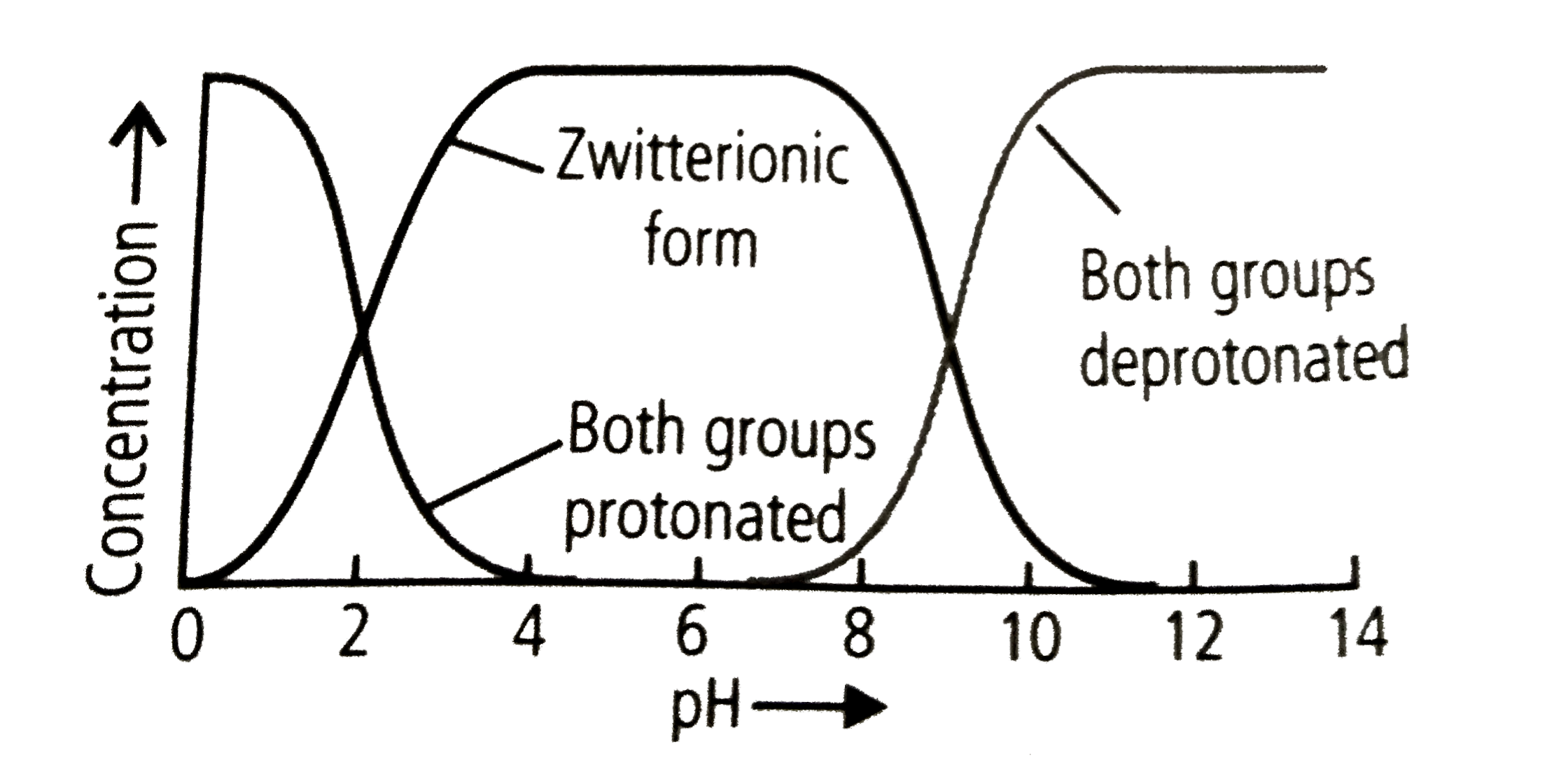What is Zwitterions.
Step-by-Step Solution:
1. Definition of Zwitterions: A zwitterion is a molecule that has both positive and negative charges but is overall electrically neutral. This means that the total charge of the molecule sums to zero.
2. Examples of Zwitterions: The most common examples of zwitterions are amino acids. Amino acids contain both an amino group (-NH2) which can gain a proton to become positively charged (-NH3+), and a carboxyl group (-COOH) which can lose a proton to become negatively charged (-COO-).
3. Chemical Equilibrium: In solution, amino acids can exist in a state of equilibrium between their neutral form and their zwitterionic form. This means that the molecule can either be in its neutral state or in a state where it has both a positive and a negative charge.
4. Charge Balance: In the zwitterionic form of an amino acid, the carboxyl group is deprotonated (loses a hydrogen ion, H+) and carries a negative charge, while the amino group is protonated (gains a hydrogen ion) and carries a positive charge. This results in one positive charge and one negative charge, balancing each other out.
5. Conclusion: Therefore, zwitterions are important in biological systems, especially in the context of amino acids and their role in proteins. They play a critical role in the solubility and reactivity of these molecules in physiological conditions.
Topper's Solved these Questions
- CARBOHYDRATES, AMINO ACIDS, POLYMERS AND PRACTICAL ORGANIC CHEMISTRYBOOK - FIITJEECHAPTER - CARBOHYDRATES, AMINO ACIDS, POLYMERS AND PRACTICAL ORGANIC CHEMISTRYEXERCISE - ASSIGNMENT PROBLEMS (SUBJECTIVE) LEVEL-II
1 Videos
- CARBOHYDRATES, AMINO ACIDS, POLYMERS AND PRACTICAL ORGANIC CHEMISTRYBOOK - FIITJEECHAPTER - CARBOHYDRATES, AMINO ACIDS, POLYMERS AND PRACTICAL ORGANIC CHEMISTRYEXERCISE - ASSIGNMENT PROBLEMS (OBJECTIVE) LEVEL-I
46 Videos
- CARBOHYDRATES, AMINO ACIDS, POLYMERS AND PRACTICAL ORGANIC CHEMISTRYBOOK - FIITJEECHAPTER - CARBOHYDRATES, AMINO ACIDS, POLYMERS AND PRACTICAL ORGANIC CHEMISTRYEXERCISE - SINGLE INTEGER ANSWER TYPE QUESTION
3 Videos
- ATOMIC STRUCTUREBOOK - FIITJEECHAPTER - ATOMIC STRUCTUREEXERCISE - NUMERICAL BASED QUESTIONS INDICATED BY DIGITAL INTEGER BY XXXXX.XX
2 Videos
- CARBOXYLIC ACIDS AND ITS DERIVATIVESBOOK - FIITJEECHAPTER - CARBOXYLIC ACIDS AND ITS DERIVATIVESEXERCISE - SINGLE INTEGER ANSWER TYPE QUESTIONS
1 Videos
Similar Questions
Knowledge Check
What is the Zwitterion?
AThe carboxyl group can lose a proton and amino group can accept a proton in the aqueous solution with give rise to a dipolar ionBThe carboxyl group can accept a proton and amino group can lose a proton in aqueous solution which give rise to a dipolar ionCThe amino group can accept a proton and ester group can lose a proton in aqueous solution which give rise to dipolar ionDThy amino group can lose a proton in aqueous solution and ester group can accept a proton in aqueous solution which give rise to the dipolar ionAssertion (A)Glycine exists as Zwitterion.
Reason ( R) It behaves as Lowry-Bronsted acid and base.ABoth assertion and Reason are correct , and Reason is the correct explanation of Assertion.BBoth Assertion and Reason are correct, but Reason is not the correct explanation of Assertion.CAssertion is correct but Reason is incorrect.DAssertion is incorrect but Reason is correct.All proteins are made up of α-amino acids which act as the building blocks. α-amino acids that are synthesised in the body, are known as non-essential α-amino acids while the one which the body fails to synthesise, are called essential α-amino acids. All of them exist as dipolar ions also known as Zwitterions. For all the α-amino acids, there is a certain pH of the medium known as isoelectric point at which the dipolar ions behave as electrically neutral species. In acidic medium, the ion migrates towards cathos while in basic medium, it migrates towards anode on passing electric current.
The isoelectric point of an amino acid isAthe pH at which it exists in basic formBthe pH at which it exists in acidic formCthe pH at which it exists in zwitterion formDthe pH equal to its Pka.
(a) Write Zwitterion structure of glycine.
(b) What is dematuration of proteins ?
View SolutionAll proteins are made up of α-amino acids which act as the building blocks. α-amino acids that are synthesised in the body, are known as non-essential α-amino acids while the one which the body fails to synthesise, are called essential α-amino acids. All of them exist as dipolar ions also known as Zwitterions. For all the α-amino acids, there is a certain pH of the medium known as isoelectric point at which the dipolar ions behave as electrically neutral species. In acidic medium, the ion migrates towards cathos while in basic medium, it migrates towards anode on passing electric current.
Which is basic amino acid ?
View SolutionAll proteins are made up of α-amino acids which act as the building blocks. α-amino acids that are synthesised in the body, are known as non-essential α-amino acids while the one which the body fails to synthesise, are called essential α-amino acids. All of them exist as dipolar ions also known as Zwitterions. For all the α-amino acids, there is a certain pH of the medium known as isoelectric point at which the dipolar ions behave as electrically neutral species. In acidic medium, the ion migrates towards cathos while in basic medium, it migrates towards anode on passing electric current.
Which of the following is not an essential α-amino acid ?
View Solution
Which of the above is Zwitterionic form?
View SolutionRefer to the given graph showing state of ionisation of zwitterion.
Select the correct statements regarding zwitterion.
(i) Zwitterions can be formed from compunds that contain both acid groups and basic groups in their molecules.
(ii) A zwitterion can act either as proton donor or proton acceptor.
(iii) A monoamine monocarboxylic α-amino acid is a acid at high pH as both the groups (amino and carboxyl) lose a proton.
(iv) Amino acids in solution at neutral pH exist predominantly as dipolar ions, the amino group is protonated (−NH+3) and the carboxyl group is deprotonated (−COO−).

View Solution
